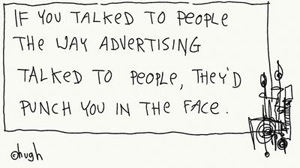
If 2006 was the year of Web 2.0 then 2007 is the year of social media. For individuals anyway. Australian businesses and politicians generally don’t “get itâ€.
Social media is mainstream. Two million Australians have Facebook pages and 3.5 million read blogs. MSN Messenger has 7 million users here, and even Ja’mie King says “I’ll MSN u 2nite†without explanation.
But few businesses use social media. Why? I suspect there’s two reasons, apart from an endemic inability to adapt and change. One is about the tools, the other is about business culture.
So far most social media tools have come from start-ups with funny names like Flickr and Twitter and YouTube. Media reports of the Next Big Thing are usually pitched as “look what those weird young folk are doingâ€. When the Next Big Thing becomes mainstream, the media ADHD attention span has moved on. So the impression is that it’s all a plaything for kiddies.
The second problem is that social media goes against the grain of how most businesses operate.
Back before the federal election, I said that politicians only see social media as a kind of TV, another outlet for their centrally-planned Soviet-style “campaigns”. Businesses have the same problem. They see 2 million Australians on Facebook and want to push their advertising at them. They see the social media websites as just another advertising medium to buy into.
That misses the point. Social media is about conversation.
Businesses are very bad at conversation.
Business usually want to pretend everything’s always perfect, and control all communication so it’s “on brandâ€.
As a result, when they try working with social media they tend to take one of two fundamentally wrong approaches.
- They act like boors at a party, loudly parroting their brand message without actually participating in the conversation. No matter what’s being said around them, they hold up a sign with their logo and shout “Product X will make you trim and sexy.” Or whatever.
- They set up their own private conversation forum — and then edit out anything negative.
Either way, people soon stop listening.
The first problem might be solved when social media tools come from mainstream providers like Microsoft. Windows Live Writer, a free blogging tool for Windows, kicks that off.
Interestingly, Microsoft itself is encouraging their staff to write blogs. Their corporate blogging policy isn’t 45 pages of legalese but a simple set of bullet points.
The second problem is harder, because it means businesses themselves need to change to embrace honesty, transparency and authenticity of communication.
Even Microsoft recognises this is a generational change. As one young employee said, “The old guard is highly competitive, the new guard is more collaborative… It’ll be at least another decade before the outside world starts recognizing the change that’s currently happening internally.â€
Coincidentally, Hugh MacLeod has written about this very issue only today, in a piece about what’s starting to be called The New Marketing. His key points for me are:
3. The most important asset in The New Marketing is “having something worth talking about”. This makes certain marketing people squeamish. A lot of us grew up in an era of flashy commercials for rather uninspiring products, and something in our DNA makes us believe that’s the proper way to go about things.
4. If I had one big insight from the last year, is how The New Marketing has everything to do with how your product or service acts as a “Social Object“. Kudos to Jyri Engestrom for turning me on to it.
And:
10. Why is it so hard to explain The New Marketing to large companies? Because the people who work there are simply not prepared to relinquish the idea of control. Live by metrics, die by metrics etc.
The “mass media” of the industrial age allowed you to mass-produce your message for… well, the masses. The “social media” of the post-industrial age allow you to hold many, individual conversations, en masse.

Disclosure: Some of the ideas in this article emerged during a geek dinner where Microsoft paid the bill. This is an expanded version of an article originally written for Crikey.
